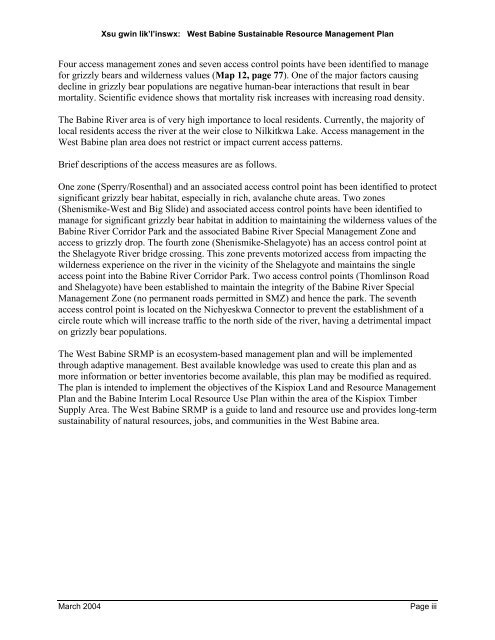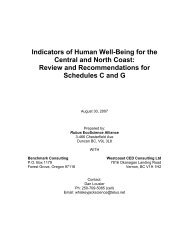West Babine Sustainable Resource Management Plan
West Babine Sustainable Resource Management Plan
West Babine Sustainable Resource Management Plan
Create successful ePaper yourself
Turn your PDF publications into a flip-book with our unique Google optimized e-Paper software.
Xsu gwin lik’l’inswx: <strong>West</strong> <strong>Babine</strong> <strong>Sustainable</strong> <strong>Resource</strong> <strong>Management</strong> <strong>Plan</strong><br />
Four access management zones and seven access control points have been identified to manage<br />
for grizzly bears and wilderness values (Map 12, page 77). One of the major factors causing<br />
decline in grizzly bear populations are negative human-bear interactions that result in bear<br />
mortality. Scientific evidence shows that mortality risk increases with increasing road density.<br />
The <strong>Babine</strong> River area is of very high importance to local residents. Currently, the majority of<br />
local residents access the river at the weir close to Nilkitkwa Lake. Access management in the<br />
<strong>West</strong> <strong>Babine</strong> plan area does not restrict or impact current access patterns.<br />
Brief descriptions of the access measures are as follows.<br />
One zone (Sperry/Rosenthal) and an associated access control point has been identified to protect<br />
significant grizzly bear habitat, especially in rich, avalanche chute areas. Two zones<br />
(Shenismike-<strong>West</strong> and Big Slide) and associated access control points have been identified to<br />
manage for significant grizzly bear habitat in addition to maintaining the wilderness values of the<br />
<strong>Babine</strong> River Corridor Park and the associated <strong>Babine</strong> River Special <strong>Management</strong> Zone and<br />
access to grizzly drop. The fourth zone (Shenismike-Shelagyote) has an access control point at<br />
the Shelagyote River bridge crossing. This zone prevents motorized access from impacting the<br />
wilderness experience on the river in the vicinity of the Shelagyote and maintains the single<br />
access point into the <strong>Babine</strong> River Corridor Park. Two access control points (Thomlinson Road<br />
and Shelagyote) have been established to maintain the integrity of the <strong>Babine</strong> River Special<br />
<strong>Management</strong> Zone (no permanent roads permitted in SMZ) and hence the park. The seventh<br />
access control point is located on the Nichyeskwa Connector to prevent the establishment of a<br />
circle route which will increase traffic to the north side of the river, having a detrimental impact<br />
on grizzly bear populations.<br />
The <strong>West</strong> <strong>Babine</strong> SRMP is an ecosystem-based management plan and will be implemented<br />
through adaptive management. Best available knowledge was used to create this plan and as<br />
more information or better inventories become available, this plan may be modified as required.<br />
The plan is intended to implement the objectives of the Kispiox Land and <strong>Resource</strong> <strong>Management</strong><br />
<strong>Plan</strong> and the <strong>Babine</strong> Interim Local <strong>Resource</strong> Use <strong>Plan</strong> within the area of the Kispiox Timber<br />
Supply Area. The <strong>West</strong> <strong>Babine</strong> SRMP is a guide to land and resource use and provides long-term<br />
sustainability of natural resources, jobs, and communities in the <strong>West</strong> <strong>Babine</strong> area.<br />
March 2004 Page iii

















